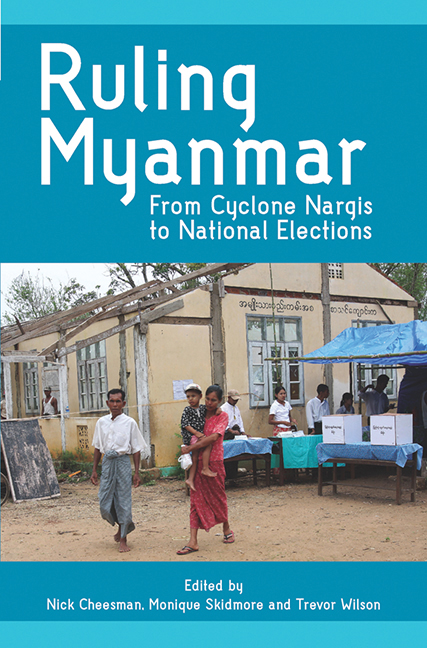Book contents
- Frontmatter
- Contents
- List of Tables
- List of Figures
- Background on ANU 2009 Myanmar/Burma Update Conference
- Acknowledgements
- Contributors and Editors
- Note on Terminology and Geographical Names
- Map of Myanmar
- Part I Overview
- Part II Political Legitimacy, Governance and Justice
- Part III Economic Development, the Rural Economy and Labour Rights
- Part IV The Role of International Cooperation and Governance
- 11 Cyclone Nargis and ASEAN: A Window for More Meaningful Development Cooperation in Myanmar
- 12 The Relief and Reconstruction Programme Following Cyclone Nargis: A Review of SPDC Policy
- 13 Positive Engagement in Myanmar: Some Current Examples and Thoughts for the Future
- 14 Normative Europe meets the Burmese Garrison State: Processes, Policies, Blockages and Future Possibilities
- 15 The Use of Normative Processes in Achieving Behaviour Change by the Regime in Myanmar
- List of Abbreviations
- Index
15 - The Use of Normative Processes in Achieving Behaviour Change by the Regime in Myanmar
from Part IV - The Role of International Cooperation and Governance
Published online by Cambridge University Press: 21 October 2015
- Frontmatter
- Contents
- List of Tables
- List of Figures
- Background on ANU 2009 Myanmar/Burma Update Conference
- Acknowledgements
- Contributors and Editors
- Note on Terminology and Geographical Names
- Map of Myanmar
- Part I Overview
- Part II Political Legitimacy, Governance and Justice
- Part III Economic Development, the Rural Economy and Labour Rights
- Part IV The Role of International Cooperation and Governance
- 11 Cyclone Nargis and ASEAN: A Window for More Meaningful Development Cooperation in Myanmar
- 12 The Relief and Reconstruction Programme Following Cyclone Nargis: A Review of SPDC Policy
- 13 Positive Engagement in Myanmar: Some Current Examples and Thoughts for the Future
- 14 Normative Europe meets the Burmese Garrison State: Processes, Policies, Blockages and Future Possibilities
- 15 The Use of Normative Processes in Achieving Behaviour Change by the Regime in Myanmar
- List of Abbreviations
- Index
Summary
INTRODUCTION
A common characteristic of most policies towards Myanmar/Burma is to seek to achieve some change for the better in the situation in the country despite the continued authoritarian rule of the military regime. This more modest change agenda was necessitated by the lack of any prospect of bringing the case of Burma to the UN Security Council. As at mid-2009 no external strategies (or, for that matter, internal strategies) have been especially successful in accomplishing much improvement, and certainly not in the sense of achieving “regime change”. Few organizations conducting programmes there would even claim to have accomplished much success in pressing for systemic change, and so surprisingly few attempts have been made to rigorously assess or measure the extent of change attributable to these policies.
Nevertheless, there is some point in examining objectively what approaches have succeeded in accomplishing a modest degree of behaviour change by the military regime. Whether these changes have been caused by applying pressure, through sanctions or some other strategy, or, on the other hand, by using persuasion, or even some combination of the two, is not the ultimate test in this case. Yet, despite the claims to the contrary by the regime's critics, there is ample evidence of certain changes in its behaviour resulting from particular strategies. These changes may not have been sufficient to make Burma/Myanmar fully compliant with relevant international norms, but they can be documented, may have become “permanent”, or may be a key step in a transitional process.
It would be instructive to look carefully and dispassionately at what changes have occurred in Myanmar/Burma and to try to establish why they happened. Where we are faced with a regime as averse to reform and “democratic” processes and as wedded to controlling events, an intelligent mix of strategies is likely to prove to be the best approach in seeking to bring about improvements. This is based on the obvious proposition that there clearly is no “magic bullet” solution and that, realistically, short of invading Myanmar/Burma, outside countries are extremely limited in what they can achieve there.
- Type
- Chapter
- Information
- Ruling MyanmarFrom Cyclone Nargis to National Elections, pp. 294 - 318Publisher: ISEAS–Yusof Ishak InstitutePrint publication year: 2010



